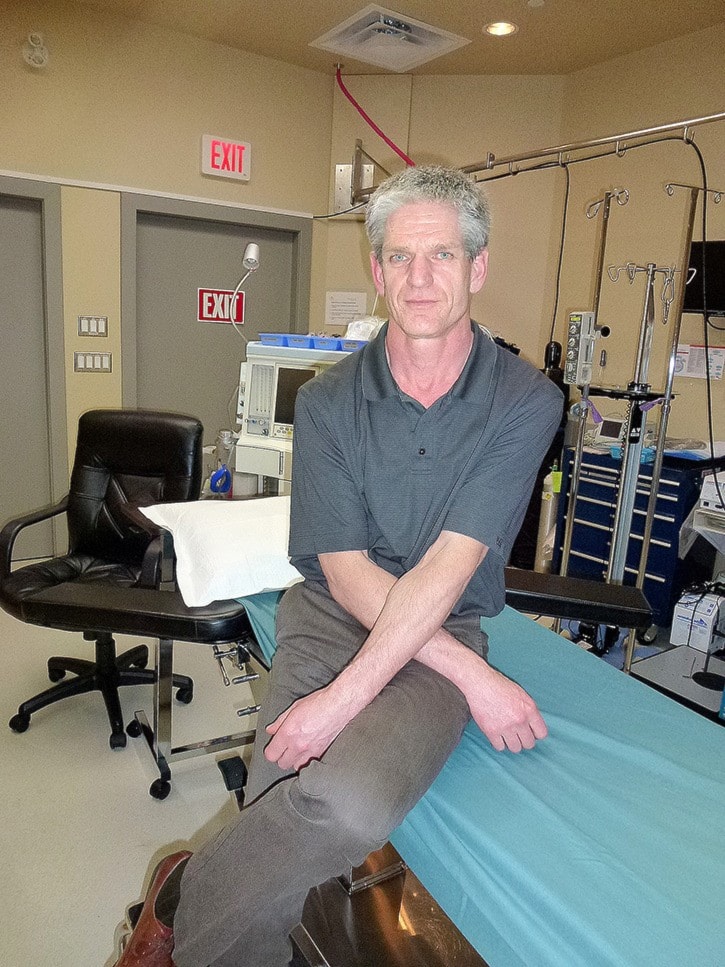Peace Arch Hospital’s chief of surgery says the facility has made strides in maximizing efficiency to avoid penalties imposed by the B.C. Ministry of Health on the Fraser Health Authority for undue waits for non-emergency surgeries.
But Dr. Arno Smit also says Fraser Health needs to authorize full use of potential OR time at the hospital – rather than the 80 per cent he says the facility has been limited to in recent months – to avoid a waiting-list crisis in the future.
“Our most serious challenge is providing timely care for conditions that are not considered life-threatening,” Smit, a White Rock orthopedic surgeon, said.
He warned that staff are reaching a “tipping point” of morale due to frustration over OR-use limits – which he feels threatens advances the hospital has made.
Smit suggests Fraser Health authorize full use of OR capability, in anticipation of a new budget and potential funding increases, rather than wait for increases to materialize.
But Dr. Peter Blair, director of surgical programs for Fraser Health, said the suggestion is “ridiculous.”
“It would be incredibly irresponsible for anybody to do that,” said Blair, who helps plan the operations side of resource allocation.
“This is public money and if every hospital in the province behaved that way we would have a real problem.”
Smit said Peace Arch has been dealing with a 20 per cent operating-room reduction instituted across the region by the Ministry of Health in October.
“We spent several years collectively optimizing efficiency in ORs, but we have been penalized for being effective.”
But Blair disputed Smit’s calculation that Peace Arch ORs have been operating at 80 per cent. He said surgeries had been reduced because Fraser Health’s surgical program had been operating “well over the allocated budget in January and February.”
“We amassed quite a large debt and we had to get that back in line with the budget, so we reduced the number of surgeries,” he said. “The new budget isn’t out yet, so we intend to keep the same rate for the time being. We’ve asked for an increase in the budget, and we fully expect to get one, but we need to wait until it comes.”
Blair said any increase would be “distributed to the sites wherever would have the greatest impacts on waiting lists.”
Smit, who became chief of surgery last October, was sharply critical of Fraser Health two years ago for missing out on $2.6 million in incentive funding for failing to meet provincially mandated wait times for knee and cataract surgery in 2010-’11, advocating wait times of no more than six months rather than the two years experienced in some cases.
“Six months would be completely reasonable, but we don’t have it at this point,” he said last week, noting hospital efficiencies instituted over the last two years have reduced wait times, which have also been mitigated by use of ORs at other facilities.
“But we have surgical space that is under-utilized and there has been little improvement over the past few months.”
Smit warned that the reduction threatens any advances the hospital has made, and is leading to an overall increase in waiting lists for smaller procedures.
“Local management has to comply with directives from the health ministry, but the whole program is being fragmented as people are looking for places to get their surgeries done,” he added. “Whatever we hope to save by not doing surgery here is being negated by allowing them to be done elsewhere.”
Smit said the situation leads to growing unrest among medical staff.
“Staff finds itself torn between being an advocate for the patient and recognizing the need for fiscal stability and responsibility. There is a tipping point and that point is near.”
Discrepancies in provincial funding between Fraser Health and other health authorities are also a concern, Smit said, following a report by B.C.’s auditor general in February.
It showed Fraser Health has the lowest per capita funding per year in B.C., at $1,585 (in 2011-’12) – in comparison with Vancouver Coastal Health, which received $3,008 per capita. Vancouver Island Health received $2,554, Northern Health received $2,465 and Interior Health received $2,372.
Smit acknowledges there are explanations for the discrepancies relating to geographic areas covered and the distribution of population in the other authorities, and that he has heard Fraser Health will receive an increase of 14 per cent in per capita funding over three years, rather than seven per cent over two years.
“But the population within Fraser Health is growing faster than for other authorities – we’re probably still falling behind,” he said.
